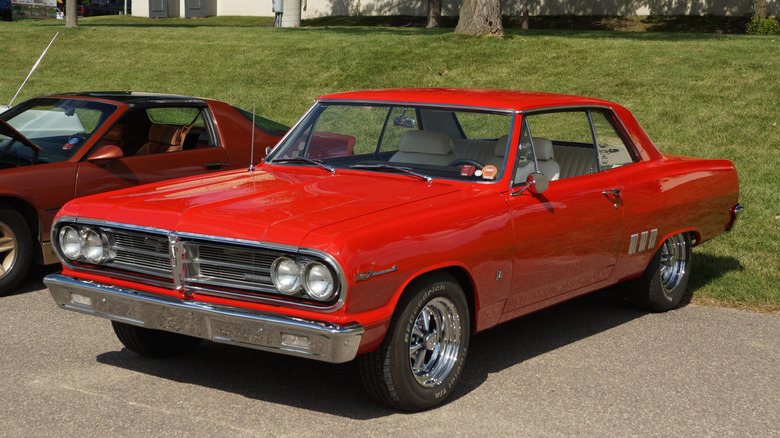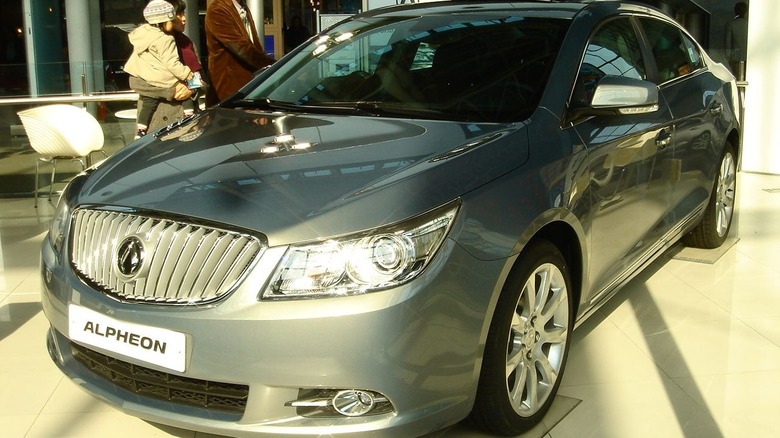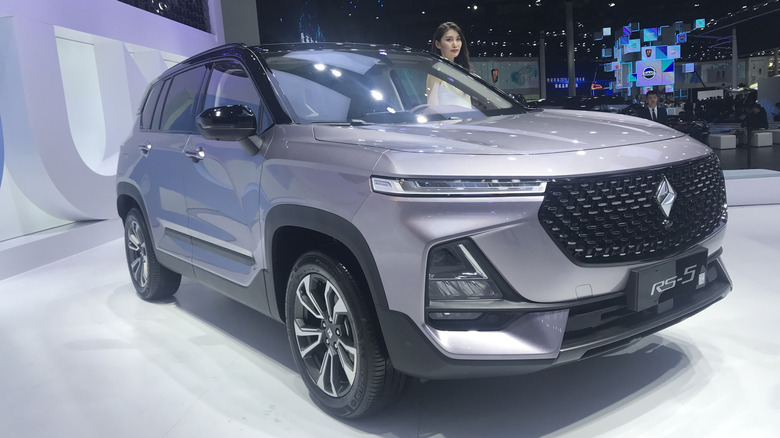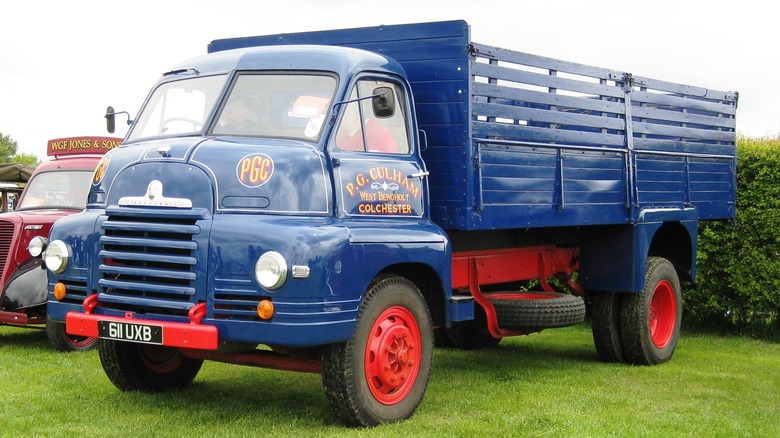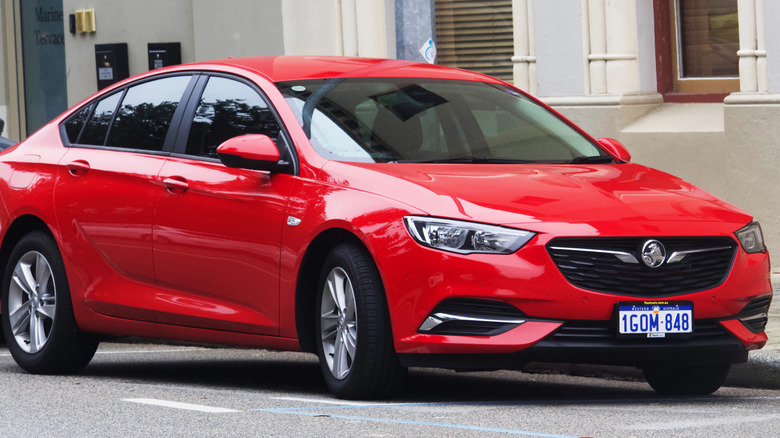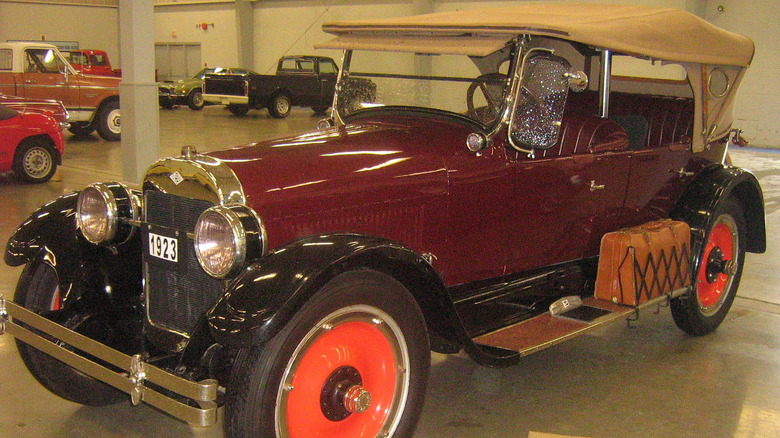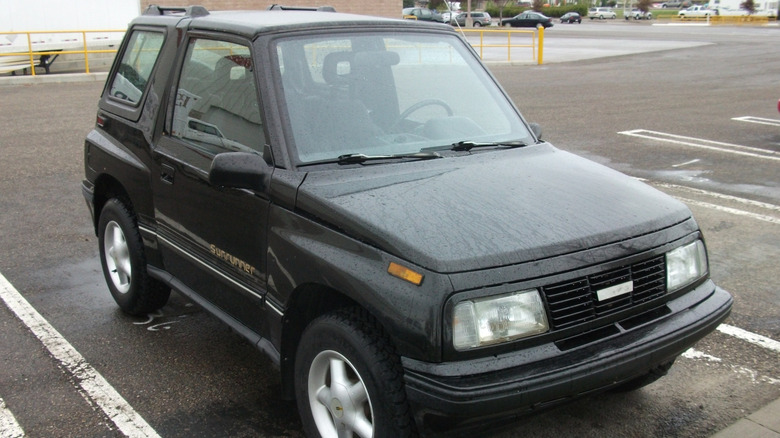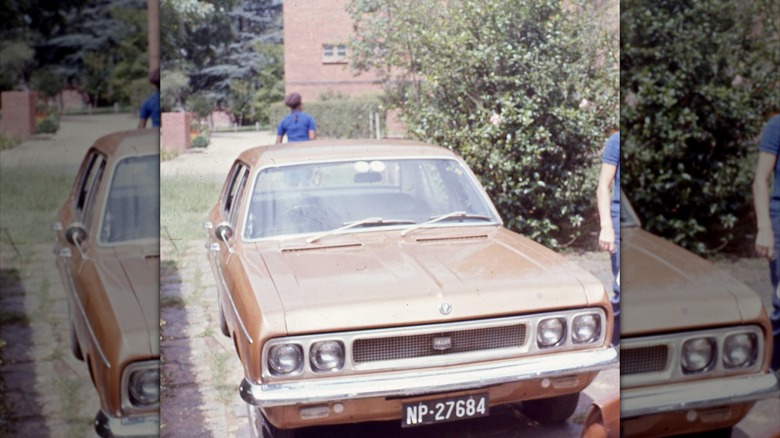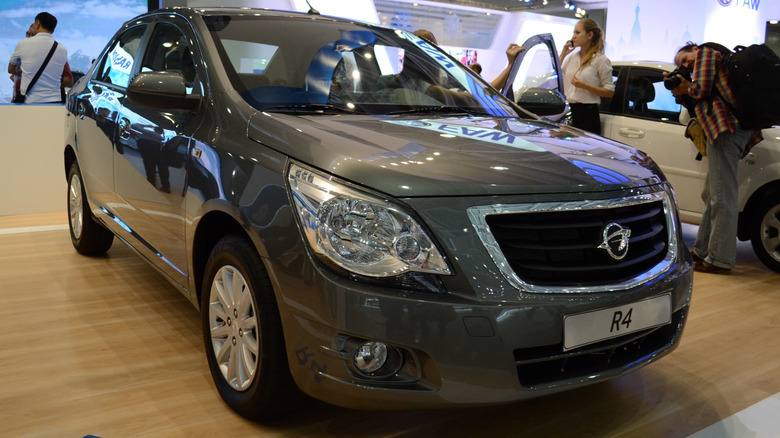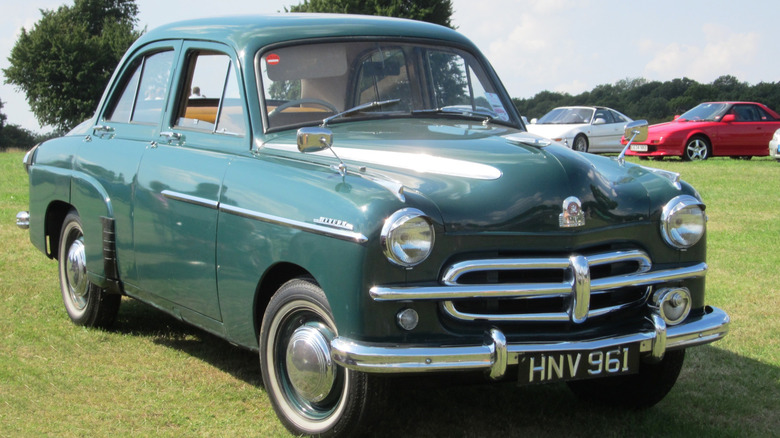10 GM Car Brands That Were Never Sold In The US
William Durant was an empire builder. Even before he turned Buick into the biggest player in domestic automobile industry, he had already previously turned a struggling carriage builder into the largest manufacturer of vehicles in the United States. And he had even bigger ambitions. Under his leadership, Buick and Oldsmobile merged into General Motors, which then went on an acquisition spree, adding famous brands like Cadillac and Pontiac, as well as establishing the Chevrolet division to sell affordable cars.
GM's acquisitions weren't limited to companies in the United States, either. It bought manufacturers in Canada, the United Kingdom, Germany, and Australia. By 1931, it was the world's largest manufacturer of cars and trucks, a title it would hold until Toyota surpassed it in sales 77 years later. During its heyday, it would go on to buy or create brands in Asia, South Africa, and elsewhere. The company became a true global giant, and remains so to this day.
Some of GM's international brands were sold in the United States under their own brand names at various times. For instance, Opel cars such as the Rekord, Kadett, Manta, and GT were sold as Opels through Buick dealerships from the late 1950s to the early 1970s. Other Opels came rebadged as Chevrolets, Saturns, and other domestic brands, until General Motors sold Opel in 2017. GM took that approach with many of its non-Opel foreign brands, too — in fact, many never came to the U.S. under their own brands at all.
Acadian/Beaumont — Canada (1962-1971)
To get around Canada's tariffs on American-built cars, GM began building Canada-specific models in Canada. In 1962, it launched a Canada-only brand called Acadian, which it sold through Pontiac-Buick dealers. Prior to that, GM sold Canadian-built Chevys and Pontiacs, the latter of which were equipped with Chevy engines, unlike their U.S. counterparts at the time. When Acadian came to market, its cars were initially based on the compact Chevy II X-body platform, one of the most iconic Chevrolet model lines of that era and the basis for the Nova muscle car. The Acadian line ranged between an entry-level model called the Invader and the premium Beaumont model.
In 1964, the Acadian Beaumont became a Chevelle-based model, and two years later, Beaumont was spun off into its own one-model brand. As an Acadian Beaumont and a just-plain Beaumont, the car shared its chassis and sheet metal with the Chevelle and used a range of Chevy engines. Its grille differed from Chevy's, so Canadian car enthusiasts could tell them apart. The top-of-the-line SD trim could be equipped with Chevy's L79 327-cubic-inch V8, which generated a potent 350 hp, though records show that only 23 out of almost 9,000 Acadian Beaumonts were built with that engine in 1965.
1965 was also the year that the Automotive Products Trade Agreement (APTA) went into effect between the U.S.A. and Canada, eliminating the tariffs that had led to Canadian-built, Canada-specific models. The Acadian and Beaumont brand names survived for a few more years before fading into the automotive history books.
Alpheon — Korea (2010-2015)
Alpheon was a short-lived GM brand in South Korea. GM had already been selling Chevrolets under Chevy's brand name in Korea for several years. It was planning to introduce a Korean-built version of the Buick LaCrosse, but faced a quandary. It didn't want to badge the Buick as a Chevy, but Buick had no brand presence in Korea. The solution was to create a standalone brand called Alpheon to market the LaCrosse as a luxury product. It would initially be sold through Daewoo dealers since GM had purchased that Korean brand in 2001, although in 2011, GM Daewoo changed its name to GM Korea.
The Alpheon brand would be sold alongside Chevrolet models by Daewoo and then GM Korea, but it had its own brand name and logo, marking it as a distinctive, luxury-oriented marque. Alpheon was an anomaly for GM during that period, since financial difficulties had caused it to shed multiple brands in the previous few years. Alpheon was a rare instance of GM creating a new brand in the face of economic headwinds. GM even considered taking the Alpheon brand global, although those aspirations never came to fruition. Production issues limited the number of Alpheons that were built, and in 2015 Alpheon joined the list of GM's discontinued car brands.
Baojun — China (2010-present)
As it does in the U.S., GM pursues a multi-brand strategy in the world's largest automotive market, China. Some brands will be familiar to Americans, including Chevrolet, Buick, and Cadillac. Others are among GM's overseas divisions, including Opel from Europe and a joint venture in China called SAIC-GM-Wuling. In 2010, this partnership announced a new brand called Baojun, intended to produce inexpensive automobiles to meet the ever-growing Chinese appetite for new vehicles. Baojun's cars are priced below Chevy models, and the company quickly grew into one of the most popular GM brands in China.
Within seven years of its introduction, it trailed only Buick in sales among GM's divisions in the country. It surged to become the eighth most popular brand among more than 100 existing brands in China when it was launched. Its initial success resulted from developing small and medium-sized crossovers and SUVs based on older GM platforms, which kept costs down and enabled Baojun to offer entry-level prices. It marketed a diverse vehicle portfolio to buyers in second-tier cities.
Models like the 510 SUV (based on an old GM SUV architecture) and the 530 SUV helped establish the brand in a hyper-competitive market. The brand also embraced China's massive transition to electric vehicles with models like the E100 and E200 city-EVs. This approach put Baojun in a good position to meet mandates for electric and hybrid car production that went into effect in 2019.
Bedford — United Kingdom (1931-1986)
Bedford was established in 1931 as the commercial vehicle division of GM's Vauxhall subsidiary and would go on to produce some of the best-known trucks and vans in the U.K. For over five decades, Bedford offered trucks that ranged from car-derived vans to semi-trucks, known in the U.K. as articulated lorries or tractor units. During World War II, it produced tens of thousands of specialist vehicles for the British Armed Forces. For example, the MW series was a light general service lorry that transported everything from troops to cargo.
In the 1950s, the S-type became the basis for numerous trucks, including the RLHZ Self-Propelled Pump fire truck, also known as the Green Goddess. In 1960, Bedford launched the TK series line of trucks, which proved to be one of its most successful models. Through 1984, more than half a million TKs would be built, in a range of configurations and weight classifications up to 17 tons. For heavier applications, Bedford also introduced the KM series and later the more advanced TM range in 1974, featuring a modern square cab design.
Bedford also produced popular van models like the CA, CF, and HA series, as well as the Chevanne and the Astravan. The Bedford CF van is one of a few real-life vans that look like the Mystery Machine from Scooby-Doo. The final new Bedford was the TL range in 1980, which replaced the TK, but shared many features with it. Bedford ceased truck production in 1986, but many of its vehicles are considered classics.
Holden — Australia (1931-2020)
The final Pontiac GTO was a rebadged Holden Monaro, and some Holden Commodores wore a Chevy badge, becoming the Chevy SS for the U.S. market, but GM's Australian brand never had its own presence on American shores. That meant the Yanks were denied the chance to drive some terrific models over the decades.
GM bought Holden in 1931 as part of its early wave of international expansion. It became an iconic brand within Australia's lively car culture. For instance, Holden Special Vehicles, a performance brand within Holden formed in collaboration with Tom Walkinshaw Racing, would transform cars and utes like the Holden Commodore and the Holden VU Ute into world-class performance machines. Plus, Holden trucks and cars were used to build some of the coolest Mad Max vehicles from the famous movie franchise.
Other famous Holden models included the amazingly spacious HK Kingswood station wagon, the race-winning 1968 Monaro coupe, the compact but powerful Torana, and the HQ Statesman luxury sedan. Holden also catered to Australia's taste for "utes," or vehicles with passenger-car front ends and pickup beds in the rear, similar to the Chevy El Camino. These included the HZ Sandman and the unique Holden HSV Maloo, one of the fastest utility vehicles ever made. Alas, changing attitudes toward fast cars and GM's financial troubles led the General to shut Holden down, leaving its performance legacy as just a memory.
McLaughlin — Canada (1907-1942)
The McLaughlin Motor Car Company played an outsized role in the Canadian auto industry's history, having been the seed from which GM Canada grew. It also played a role in one of the greatest scandals in the British Royal Family's history. Founded by Robert McLaughlin in 1869, the business grew into one of the largest carriage makers on Earth. In 1907 Robert's son Sam imported Buick engines to begin building cars which eventually became known as McLaughlin-Buicks. The company also built Chevrolets in Canada, and in 1918 it changed its name to GM Canada.
Although GM Canada's McLaughlin models used Buick running gear, Sam McLaughlin's sense of style made them easily distinguishable from Buicks in the U.S. They were available in multiple body styles and came with a range of four-cylinder and six-cylinder engines. As time went by, however, the cars became more like U.S.-built Buicks, and in 1942 the McLaughlin name was dropped. The cars became known simply as Buicks.
Before that happened, however, a McLaughlin-Buick limousine played a role in history. King Edward VIII rode to 10 Downing Street in it on a December night in 1936 to inform the Prime Minister that he intended to abdicate the throne in order to marry American divorcee Wallis Simpson. They would later leave for their honeymoon in the same car.
Passport/Asuna — Canada (1988-1994)
Two Canada-only brands, Passport and Asuna, can be lumped together as a single failed experiment by GM Canada. In the 1980s, on both sides of the U.S.-Canadian border, General Motors was obsessed with fighting off the wave of small imports that had taken so much of its business in the previous decade. In the U.S., that led to the creation of Geo, a Chevrolet sub-brand established to sell imported models in Chevy dealerships without having to put Chevy badges on them. GM Canada used that same philosophy of "if you can't beat them, join them," giving birth to the Passport brand. Passport actually beat Geo to market by a year, debuting in 1988 with a range of rebadged Isuzu, Saab, and Daewoo cars and SUVs.
Passport's brand identity was muddled at best, and by 1991 things got even more confusing when Geo and Saturn arrived in Canada as import fighters. Passport dealers became Saturn-Isuzu-Saab dealers, but GM Canada wanted to take another crack at the rebadged import game. This led to the creation of Asuna in 1990. Asuna was to serve the same role for Pontiac-Buick-GMC dealerships as Geo served for Chevy dealers, giving them an entry to the import game. The brand's lineup included the Suzuki Vitara-based Sunrunner SUV, the Isuzu Impulse-based Sunfire coupe, and a model called the Asuna SE and Asuna GT that was based on the unloved Pontiac LeMans subcompact. With this weak selection of models, Asuna faded away by 1994.
Ranger — South Africa, Belgium, Switzerland (1968-1978)
For about a decade, GM had a third European brand called Ranger, which was also sold in South Africa. It mostly sold rebadged Opel models in these markets from 1968 to 1978. Rangers were assembled from existing GM models and parts, combining Opel bodies, Vauxhall grilles, and quad-headlamp bezels that resembled very little else in GM's parts bin, possibly making them the only thing unique to the brand. The lineup consisted primarily of the Ranger A and Ranger B (called Ranger II in Belgium), available in a range of coupe and sedan bodies. South African models were also available as wagons.
Rangers featured various four- and six-cylinder engines, with the top option being a twin-carb version producing 140 hp. Production was localized, with Ranger models built in factories across Switzerland, Belgium, and South Africa. Ranger suffered from unclear brand identity, since GM also sold Opels and Vauxhalls in Ranger's markets. It's possible that Ranger was offered to help plug holes in its lineups in Switzerland and Belgium. Ranger survived a full decade before GM discontinued it. Today, these vehicles remain virtually unknown in America, even to some of the most knowledgeable GM enthusiasts.
Ravon — Uzbekistan (2008-present)
Next, we come to another brand that diehard GM fans may have never heard of. GM acquired Uzbekistan's Uz-DaewooAuto in 2008 when it purchased South Korea's Daewoo. The newly renamed GM Uzbekistan now sells two brands, Chevrolet and Ravon, with the latter originally intended partly for export to the Russian market. However, since Russia's invasion of Ukraine in 2022, GM has abandoned the Russian market. Ravon was also slated to build a sedan for the Domestic Uzbek market. The Uz-Daewoo branded cars were rebranded as Chevrolets.
GM Uzbekistan endured a scandal in 2016 when its general director and several other executives were charged with fraud, money laundering, and other accusations. The controversy centered around an alleged scheme where vehicles meant for export to Russia only reached Kazakhstan before being redirected and sold in Uzbekistan at much higher prices, with executives allegedly pocketing the difference. The scandal may reflect political struggles between rivals within Uzbekistan.
Presently, the website for UzAuto (as the GM Uzbekistan is also known) shows only Chevrolet models, so it's difficult to know whether the combination of scandal and the loss of the Russian export market after the invasion of Ukraine has led to the Ravon brand being discontinued or suspended. Recent news about Ravon is nearly impossible to find.
Vauxhall — United Kingdom (1925-2017)
Vauxhall is Britain's oldest surviving carmaker. Founded in 1857 to build engines for steamships, it transitioned to building cars in 1903, and GM bought it in 1925. The transatlantic partnership lasted until GM sold Vauxhall to France's PSA Group, maker of Peugeot and Citroen vehicles, in 2017. Four years later, PSA merged with Fiat Chrysler to form Stellantis, making Vauxhall one of the car brands that Stellantis owns.
It's been a long journey since Vauxhall built its first car more than a century ago. The brand is named after London's Vauxhall Gardens, which were themselves named after a medieval nobleman whose griffin coat of arms adorns every Vauxhall car today. One of Vauxhall's first models was called the Prince Henry, which was completed in 1914 and is regarded by many as the world's first sports car. GM bought Vauxhall 10 years later to bring the British company's engineering expertise to the task of expanding GM's presence in Europe. Soon after, Vauxhall launched its Bedford sub-brand to build trucks and other commercial vehicles.
In the post-war era, the brand sold millions of cars while other British automakers struggled. Some of the most popular cars in British motoring history came from its factories, including the Viva, the Chevette, and the Cavalier. During the 1980s and 1990s, Vauxhall enjoyed a spirited rivalry with Ford that saw it match Ford model for model. GM actually did briefly sell one Vauxhall model in the U.S., the Vauxhall Victor, in the late 1950s and early 1960s, but the brand never established an ongoing presence in America, unlike Opel.

